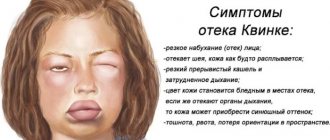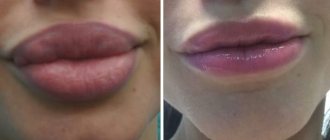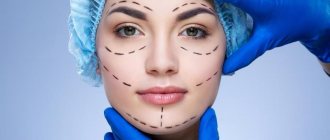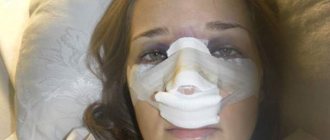Leave feedback
Sign up for a consultation
Secondary rhinoplasty (also called revision rhinoplasty) is performed to correct problems that remain after the primary intervention. If very often the reason for primary rhinoplasty is aesthetic problems, then revision rhinoplasty is directly related to health issues.
As a rule, revision rhinoplasty is performed because the first operation was unsuccessful. If the problem is a plastic surgeon’s mistake, then, of course, the patient prefers to see another specialist. And in this case, the choice of doctor must be especially careful: after all, the surgeon will have to operate with a lack of information. The fact is that after surgery, the condition of the tissue can change greatly, so revision rhinoplasty is an extremely delicate operation, the main task of which is to correct deficiencies while maintaining advantages.
But there are other reasons why rhinoplasty can be considered unsuccessful. First of all, this is the patient’s failure to comply with the doctor’s recommendations during the rehabilitation period. Accidental damage to the operated nose, caused by negligence, can negate the surgeon’s efforts, and instead of the attractive appearance that you already observed during computer modeling before plastic surgery, you can get a completely unpredictable result.
And finally, the third reason why patients sometimes seek revision rhinoplasty is subjective dissatisfaction with the results of the operation. Any plastic surgeon will tell you that you can evaluate the results of rhinoplasty no less than 6 months after it is performed. Any comparison of photographs before and after rhinoplasty (which is the most important argument) makes sense only after the end of the recovery period. But not every patient has the patience to wait for this moment. In particularly sad cases, no conversations with the doctor who performed the operation help, and the patient turns to another specialist with a demand to urgently correct the situation. However, revision rhinoplasty is also possible no earlier than six months after the initial operation, and no self-respecting surgeon will undertake to do it earlier.
In what other case will the doctor refuse to immediately perform revision rhinoplasty? If there are medical contraindications - for example, during exacerbation of certain diseases, during pregnancy.
There is another reason. A certain percentage of patients seeking rhinoplasty do not have problems with the shape of the nose at all, but purely psychological ones. A good surgeon will identify such a patient during the first consultations. But there are clinics that work on the principle of “any whim for your money.” In this case, the patient who has undergone plastic surgery remains dissatisfied with its results and turns to another rhinoplasty surgeon... If he has chosen a conscientious doctor, he will refuse to perform a repeat operation and will find a way to convince the patient to work with a psychotherapist.
Which noses are classified as “complex”?
- Noses that were repeatedly broken.
- Noses that “resulted” from unsuccessful corrections in other clinics.
- Deformation of the nose due to increased scarring.
- Genetically determined features of the appearance of the nose.
If the “complicated nose” has not undergone plastic correction before, operations are carried out in several stages, as thoughtfully and carefully as possible. If rhinoplasty is performed after a surgeon’s mistake, then a thorough diagnosis using various methods (for example, MRI) is required in order to see and evaluate the results of previous corrections as accurately as possible. Only after this can you draw up a plan for your operation, if, of course, the correction is still possible to carry out with a successful result.
When can you have revision rhinoplasty: if you just don’t like it?
Some people are not satisfied with the results of primary rhinoplasty simply because they cannot decide on the shape of their nose. He is so keen on plastic surgery that he remakes his face many times. If the nose looks aesthetically pleasing, breathing is not impaired, and the person just wanted something new, it is not advisable to undergo surgery. With each operation, there is less and less material left to work with, and the risk of complications increases many times over.
Main reason for revision rhinoplasty
Unsuccessful results of rhinoplasty include a nasal bridge that is too low (recessed) or too high (protruded). And if the last defect is quite easy to remove (by sanding the bridge of the nose), then if the bridge is too low, you will have to “tinker” - you will need to install a supporting graft.
It must be said that in all cases where there is not enough tissue, nose correction is more difficult to carry out. For example, growing the tip of the nose is much more difficult than making it thinner and more graceful. And a strong narrowing of the nasal dorsum is generally not amenable to plastic correction. Using filler injections (the basis of which is hyaluronic acid), you can correct the wings and bridge of the nose and create their texture.
But the most difficult and time-consuming thing is to correct the disastrous results of previous multiple plastic corrections of the nose, if there is also a lot of fibrous tissue due to hyperscarring in the surgical area. In this case, you will need to first “clear” everything, and then operate. And after the operation, during the rehabilitation period, special careful care of the nose will be required to prevent the re-formation of a large number of scars, especially for clients with oily, dense skin.
Unfortunately, in the practice of nose surgery there are also cases where plastic surgeons’ mistakes arise due to insufficient experience and skills, or due to simple inattention. Such cases include, for example, the correction of the nasal septum, which was curved during a previous operation by a beginner using plastic surgery.
Often the client simply has to refuse (if rhinoplasty is already the sixth or seventh in a row) due to the fact that his unfortunate nose may fail. It can be difficult for a rhinoplasty surgeon to do this when he understands, comparing photographs of the client before and after all operations, that it was possible to do everything beautifully and correctly from the first correction. Because of these first mistakes, you then have to resort to a whole series of corrections, which, among other things, often turn out to be not only useless, but also harmful, aggravating the situation.
Conventionally, secondary rhinoplasty is divided into three types:
- open,
- regulating
- closed.
According to statistics, the probability of needing revision surgery is 10-15%. And only 8% of patients go to the clinic again, usually to another plastic surgeon.
Indications
- Patient dissatisfaction with the result of rhinoplasty;
- Complications (perforation of the nasal septum, asymmetry, impaired breathing through the nose, subsidence of the nasal bridge, etc.).
Repeated rhinoplasty is most often performed due to patient dissatisfaction with the results obtained. A surgeon’s mistake, non-compliance with rehabilitation rules and individual characteristics of recovery - all this can lead to the need for secondary rhinoplasty.
Sometimes complications with rhinoplasty are temporary, when the patient simply does not have the patience to wait for the final result to appear. Sometimes the complications are obvious, that is, the result is objectively unsatisfactory.
Therefore, despite the prevalence of nose surgery, revision rhinoplasty is not uncommon. Often, after a previous correction, repeat rhinoplasty of the tip and dorsum of the nose is required.
Reasons for mandatory revision rhinoplasty
- Labored breathing
- Sometimes, after removing a hump, the patient runs the risk of experiencing a disproportionate decrease or increase in the height of the nasal bridge. Retraction of cartilage or damage to its bones,
- Dissatisfaction with the cosmetic effect,
- Too narrowed or overly defined tip,
- The appearance of cones
- Formation of keloid scars of the external type or on the mucous membrane, which cause discomfort
Read on topic : When should revision rhinoplasty be done?
Preoperative period of secondary rhinoplasty
Before the operation, the doctor must prescribe the patient a complete examination, including x-rays of the skull and other studies that will help him create an accurate picture of the condition of the nose - bones, cartilage, soft tissues. There is no point in resisting this and trying to speed up the operation, because the final result depends on the degree of knowledge of information.
During communication and examination, the doctor chooses the optimal correction tactics, and at this moment the most important thing is to tell the patient what can be expected from her, and what wishes will remain unfulfilled. This is a difficult moment, since in the minds of most people, plastic surgery can work wonders in any case. Patients should understand that in their case, when the previous operation has left its mark, the possibilities of correction are limited, so you need to be content with what is offered.
The result of unsuccessful rhinoplasty is often breathing problems. During repeated intervention, doctors always try to correct this defect. The patient should also understand how important this is, so the correction of functional disorders should come first for him in comparison with appearance.
Contraindications for revision rhinoplasty
- Chronic diseases: heart, liver, kidneys;
- Viral and infectious diseases in the acute stage. Tuberculosis, hepatitis, oncology;
- Inflammatory diseases of the respiratory tract, skin;
- A number of allergic diseases;
- Diabetes;
- Mental problems;
- Pregnancy and breastfeeding period;
- Anemia (anemia).
The plastic surgeon will evaluate the patient's facial skin type and condition. For patients with thin skin, all marks become more visible. And for those with thick skin and soft tissue envelope, achieving correction results is even more difficult. And you will have to wait even longer for the results to appear – often up to two years, since swelling and healing take much longer.
What methods are used to perform secondary rhinoplasty?
More often, living, autoimmune transplants from the patient's living tissues, selected from donor sites, are used.
- Auricle,
- Costal cartilage
- External occipital region.
For reference : During septoplasty, the required graft is taken from a remote part of the nasal septum.
In repeated rhinoplasty, synthetic implants Medpore, Gore-Tex and silicone are extremely rarely used. Foreign bodies are pushed out of the nose and contribute to infection of surrounding tissues.
How is secondary rhinoplasty performed?
Technically, re-intervention is more complicated than the primary one. It may be hampered by scars that occurred after the first operation, or by a lack of tissue that was previously resected.
The operation is performed open or closed:
Open revision surgery
It is used for serious disorders, when the surgeon needs to see the entire surgical field and act on the deep structures of the nose. Access is through external incisions along the lower part of the nasal septum.
Closed secondary rhinoplasty
Allows you to eliminate small defects and has a shorter recovery period. Incisions are made on the inside of the nasal passages. Therefore, the method allows you to do without external scars and scars. But during revision rhinoplasty, it is rarely used, since it is difficult to visualize the osteochondral structures.
Results of revision rhinoplasty
- Elimination of aesthetic defects.
- Restoring breathing.
- Eliminate sinus problems.
- Elimination of snoring and the intensity of seasonal allergy symptoms.
Possible risks
- Bleeding
- Wound infection
- Failure to achieve the desired result.
Medical complications occur rarely - if after the first operation there are 1% of cases, then after a second operation - 1.5%. But the result is unpredictable.
Features of the rehabilitation period
Recovery after repeated rhinoplasty lasts 7-10 days. On the seventh day, the surgeon removes the plaster cast that was applied immediately after the end of the operation. On the 3rd day after revision rhinoplasty, bandage turundas are removed from the nasal passages, which are installed for the purpose of fixation and hemostasis, sutures are removed and a number of recommendations are given that will allow the patient to reduce the risk of complications. The first time after surgery you need to:
- avoid physical activity for a month after surgery;
- give up bad habits, alcohol, fatty and salty foods that retain water in the body;
- during the first month sleep on your back;
- do not sunbathe in the sun (before going outside, use products with a high degree of protection in the area of the operation), do not visit the solarium, bathhouse, sauna for 6 months after the operation;
- Don't wear glasses for about a month.
The results of the operation can be assessed only six months after the operation, when the swelling has completely subsided and the nose has taken its “final shape.” All this time, a person should protect his nose from injury as much as possible and avoid colds with a runny nose.
Results of work
All works
Pitfalls of repeat nose surgery
Despite the surgeon's best efforts, revision rhinoplasty can be unpredictable. Therefore, the doctor should always anticipate possible difficulties and have a backup plan of action. The patient should also take note of this and before the operation do not forget to ask the surgeon what he will do if something goes wrong.
Both the doctor and the patient, even with successfully performed rhinoplasty, must be prepared for possible complications. Nasal tissues altered by a previous operation may negatively perceive the new intervention, reacting to it with inflammatory complications, graft rejection and other undesirable consequences. Therefore, it is inappropriate to be excessively strict in this case - you just need to make every effort to prevent complications, and if they occur, carry out thorough and conscientious treatment. The rehabilitation period takes a little longer.
Sometimes the consequences of unsuccessful primary rhinoplasty are, alas, irreparable. In this case, the doctor may refuse to perform a second operation. If the patient has received a refusal from several qualified specialists, then the stupidest thing he can do in this case is to continue searching until he comes across any person with a surgical diploma who still agrees to operate on him. In such a situation, the smartest thing to do would be to abandon the original idea and try to partially correct the changes with the help of cosmetic procedures. Even when performed by an experienced surgeon, surgery can worsen the condition of the nose, and the person who agrees to do it most likely does not fully understand the situation and can cause even greater harm.
The numerous problems with revision rhinoplasty bring us back to the need to choose the “right” surgeon for the initial operation. In order not to have to experience anxiety and undergo a new intervention, you should exercise care and common sense when you first contact a doctor.
Common complications of revision rhinoplasty are:
- formation of rough, difficult to remove scars;
- graft rejection;
- its deformation or displacement due to the formation of scar tissue;
- prolonged swelling (often a year or more);
- drooping of the tip of the nose due to improper tissue formation.
Read more: revision rhinoplasty part 2
The rehabilitation period after repeated rhinoplasty does not differ from the initial operation - the patient must strictly follow the instructions of the plastic surgeon.








